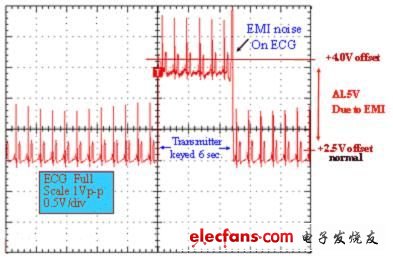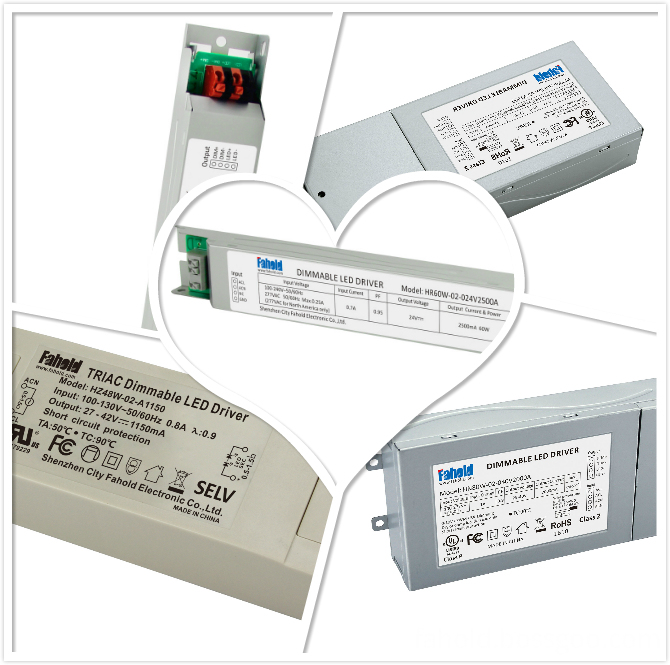How does TI EMI pass through the dielectric interference circuit?
Electromagnetic interference (EMI) is part of our lives. Over time, the intensive production of intentional and unintentional EMI sources can cause serious damage to the circuit. The signals from these sources do not necessarily contaminate the circuit, but our goal is to keep the low-noise system away from these hazards. We can imagine that a doctor uses an ECG diagnostic device to accurately diagnose the heart. Knowing that this is a high-precision measuring device, we don't worry that the annoying noise will appear in the diagnosis. This is a low frequency measurement and the electronics will not exceed 1MHz. However, if you are using an ECG device with a poor EMI design, and the doctor uses the phone to pick up the phone during the check, there is reason to worry about the diagnosis. See Figure 1.

Figure 1. The transmitter of the ECG diagnostic device turned on and off at 1.5 feet (f = 470 MHz, P = 0.5W). In Figure 1, the system's cardiac input signal is approximately 0.25 mVp-p. This small signal requires a measurement amplifier gain of around 6000 V/V. Fortunately, the situation shown in Figure 1 does not represent the actual performance of medical ECG measurement equipment. This measurement is actually used

The board shown in Figure 2 was performed in the engineer's lab. Figure 2 The front view of the precision low-level ECG heart rate meter board should not fall into this EMI trap. Carefully build the board and use some EMI-resistant components that are independent of the bandwidth of the analog or digital circuitry. When an EMI source is present near the application circuit, the source may or may not affect it. When using this low-frequency board, how does the radiated noise from the phone enter the measurement (see Figure 1)? Let's review and study the entire EMI map. In terms of EMI, there are three factors that play a role: the source of radiation, the coupling path for the propagation of radiated signals, and the radiation receptor. The source of radiation in this example is obvious. However, EMI sources may be transmitted wirelessly over the air, or through the PCB, and the source is unknown. EMI (also known as radio frequency interference, RFI) surrounds the receptor by direct conduction or various field propagation. These fields are directly coupled into the circuit connections and PCB traces and converted to conductive RFIs. The formation of a force between two charges requires three conditions: electrical, magnetic, and electromagnetic fields (radiation). The electric field (volts/distance) describes the force created by the uneven charge distribution between two physical points. In order to balance this charge distribution, a force is formed between the charges. The moving charge or current forms a magnetic field that exerts a force on all other charges around it. This field (or force) decreases rapidly as the distance increases. Note that the electric and magnetic fields are related to each other, one change and the other changes at the same time. Finally, the acceleration of the electron (or charge) forms an electromagnetic field. This electromagnetic field is the most common cause of EMI transmission.
Dim your LED-based luminaries with our dimmable LED drivers. We have Dimmable Led Driver to function with a number of different dimmers including 0-10v, Triac, PWM and more. Power your LED Luminaries with our LED Drivers. Our LED Drivers are designed for applications such as: LED home Lighting, LED Decorative Lighting, Theatre/Stage Lighting, traffic signals, and so much more. If your LED cluster or string configurations that already include a constant driver as part of the assembly, shop our Constant Voltage LED Power Supplies .0-10v Dimmer Switch Touch Panel 2. Dali Dimmable Led Driver 3. Led Dimming Driver
- Dimmable LED driver: dimmable with TRIAC and trailing edge ELV-based dimmers
- UL8750 recognized,FCC, ClassP
- AC input: 100-277VAC (230VAC nominal version available)
- Operating temperature: -30~+90°C case temperature
- Compact plastic enclosure for integrating into most light fixtures and standard electrical junction boxes
- Mounting clips featuring installer selectable mounting locations
- 5 year warranty

Dimmable Led Driver
Dimmer Switch Touch Panel,Dali Dimmable Led Driver,Led Dimming Driver
ShenZhen Fahold Electronic Limited , https://www.fahold.com